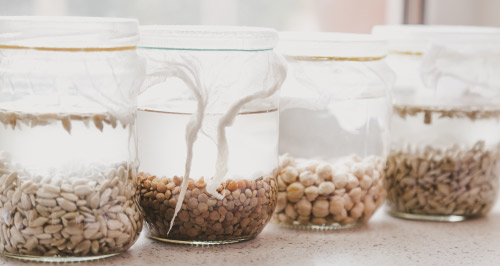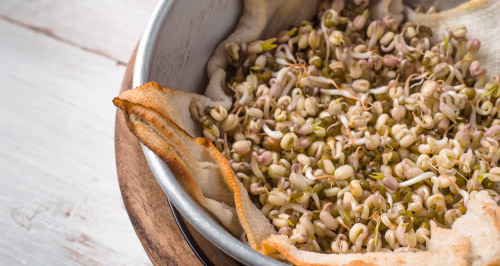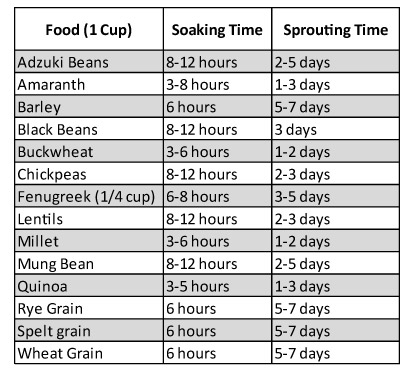
Sprouts are simply germinated seeds but are amazing raw wholefood nutritional powerhouses. Both sustainable and economical, humble beans, lentils and grains provide us with abundant fibre, healthy fats, body-building protein, starches, vitamins and minerals.
Sprouting is a way of creating stimulating the germination process with the seed, legume or grain. Sprouted foods may also be known as “pre-digested”, as the germination process helps break down the naturally occurring lectin and phytic acid (enzyme inhibitors) in the legume, allowing them to be better digested. Because sprouts are gentle on the digestive system, our bodies are able to absorb more of the minerals and vitamins each legume contains.

It’s easy to sprout all kinds of legumes with the exception of kidney beans and soybeans (their sprouts are poisonous!).
Lentils, mung beans, chickpeas, fenugreek, vegetable seeds like radish and broccoli, and grains like wheat, rye, barley, buckwheat and quinoa are all great candidates!*
Sprouting does take time, but it does not require a ton of work and is absolutely worth the wait!
HOW TO SPROUT

You can purchase tiered sprouting trays from some health food stores or online but let’s get started with some items you probably already have lying around the house: a basic piece of fine tulle netting, muslin cloth or nut milk bag and a clean wide-mouthed glass jar or canning jar. You can even use a sieve over a bowl that is well covered.
1. Soak the cleaned organic beans/grains/seeds in plenty of clean water, leaving plenty of room for growth. Tie the netting around the mouth of the jar firmly, cap or secure with rubber band and leave for the required number of hours (depending on the bean, lentil or grain) before draining the water.
2. Rinse the grains vigorously in plenty of clean water, drain and set the jar aslant downwards in a dish or dish rack to let all the water out – through the netting. Each time you do this make sure to toss and aerate your sprouts also.
3. Repeat the rinsing process twice a day until tiny sprouts start to emerge. Note that sprouting times may vary depending on the temperature also, with warmer climates generating faster sprouting times.
4. Once they’ve sprouted enough you can keep these little guys refrigerated to stop further growth and they will be good to eat for the next few days. You’ll have fresh crunchy sprouts to use in your salads, top stir-fries, incorporate into sprouted bread, dehydrate to make granola and other snacks or even blend to make sprouted hummus and other dips!

*NOTE:
Most Australian grown organic and natural beans, peas and grains may be able to sprout. Any seeds with an origin outside of Australia could have been slightly heat treated on entry in order to adhere to quarantine laws and will most likely not sprout.
All our products are either certified organic, non-GMO and grown without the use of insecticides or pesticides and harvested and packed without the use of preservatives and additives and not radiated. Unfortunately, we can not guarantee that any grains, nuts or seeds will ‘sprout’ as sprouting is an exacting science which depends on factors including harvest time and age of the product, type of product & when it germinated naturally, also the pH, mineral, salt content and water temperature


![Urban Forager [Supplier Spotlight] Urban Forager [Supplier Spotlight]](https://cdn11.bigcommerce.com/s-dis4vxtxtc/images/stencil/160w/uploaded_images/urban-forager-thumb-1-.jpg?t=1713225090)


